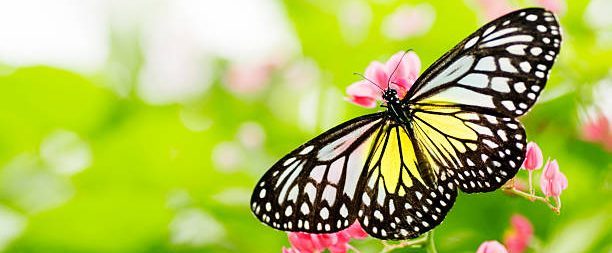Here’s been much talk in recent times (and rightly so) about the decline in bee populations around the world. Yet, there is another species whose numbers are dwindling right here in the UK and there has certainly been less information about this in the media, or even on online forums.
We are talking about, of course, butterflies. There are 57 native species of butterfly in the UK and we are also lucky enough to be visited by both the clouded yellow butterfly, and the aptly named ‘painted lady’ who regularly visit our shores from abroad.
There are several reasons why we are seeing less and less butterflies around in Britain, and we will go into them in this article. We will also teach you everything you need to know about butterflies: their habitats, what they live off, their anatomy, and most importantly, how to protect them, or at least make things a bit easier for our winged little friends.
So, let’s dive straight in with why we should be looking out for our butterflies.
Why are butterflies important?
Just like bees, butterflies are pollinators. Maybe not to the same level of bees, but they are still a very important part of the ecosystem. In fact, one clear sign that an ecosystem is thriving, is the appearance, and abundance of butterflies in that area, and the absence of them obviously points to problems in said ecosystem.
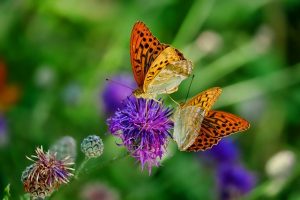
Butterflies are an important part of the food chain, acting as a source of nutrition for birds, and also eating aphids that can damage plants, but only select species do this. By eating some species of weeds , butterflies help other plants to grow, and on top of that, they help to keep the growth of some plants under control by eating their leaves.
In addition to all this, they also act as a kind of natural caretaker, eating natural garden waste such as animal excrement, and fruit that has begun to decay and rot. So you see, these insects are actually not just a pretty face, and are really important to keeping the environment healthy, so it’s in everyone’s best interests to take care of butterflies.
Why are butterfly numbers declining?
I spend more time outdoors than most, and I have for as long as I can remember, so the lack of butterflies may seem more obvious to me. Even when I think back to when I was a child, playing in the local fields, I always remember seeing butterflies, but this sadly isn’t the case these days, and I saw a report that claimed a 77% drop in habitat specialist butterfly species in the last four decades, and a less, but still worrying 46% drop in ‘wider countryside’ species. One species in particular, the high brown fritillary, has seen its numbers decline by 94%, potentially lining it up for extinction.
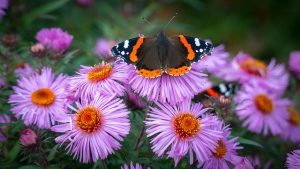
So what is causing the decline in the number of butterflies in the UK?
Well, like with most things, there are a number of factors that all contribute to the problem. The most obvious being the urbanisation and development of rural areas, and climate change.
The impact of housing developments, as well as increased farming, on the lives of butterflies shouldn’t come as surprise to anyone. If you replace the insect’s natural habitats, food source, etc. to use the land for other purposes, it’s going to adversely affect them.
With climate change, we have seen increasingly unpredictable weather, and also more extreme weather, and this too can harm these colourful pollinators. Cold and wet weather can actually kill butterflies, who love the sunshine, so unexpected, or out of season, drops in temperature or intense rainfall, have had a hand in the butterfly population dropping too.
The use of chemical pesticides in people’s gardens has increased a lot of the last forty years, and this too has played a part in the butterflies’ demise. A lot of amateur gardeners use these products to get rid of things like aphids, not realising that there are natural ways to deal with them, and that by spraying pesticides they are actually killing harvester butterflies which are a natural predator of said aphids.
There is some good news though, in recent years butterfly conservationists have done great work that is showing results of slowing the rate of the drop in butterfly numbers, and these projects will probably be expanded in the future to cover larger areas.
Butterfly life cycle
I’m sure most of us either read the hungry caterpillar book when we were kids, or we’ve read to our own children and grandchildren, and for a lot of us, it was the first time we learned that caterpillars turned into butterflies.
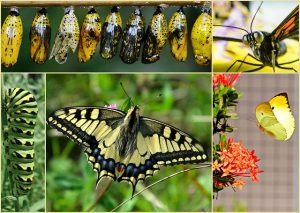
I remember being amazed at this new information, and got my mum to take me to the library to find a nature book that had more information on the subject, and then went out to try to find evidence of butterfly eggs on leaves or caterpillars themselves.
Anyway, for anyone who doesn’t quite remember the life cycle of butterflies: here it is-
Stage 1-the egg
Butterfly eggs are usually laid on the leaves of plants, and depending on the species of butterfly, they can either be round, oval, or even cylindrical. They are very small, but sometimes you can observe the caterpillar inside if you use a magnifying glass.
This stage of the butterfly’s life is usually 3-7 days long.
Stage 2- the caterpillar
Once the caterpillar hatches from the egg, it goes on a feeding frenzy, just like in the kid’s book. The caterpillar needs to consume all of this food as it grows so quickly. By the time it is ready to go on to the next stage of the life cycle, a caterpillar can be 100 times larger than when it first hatched from the egg, and will shed its skin multiple times in the process.
Stage 3- The Chrysalis
Once the caterpillar is fully grown, it will enter stage three and form a chrysalis, also known as a pupa when describing other insects. Inside this chrysalis, the caterpillar goes through a metamorphosis, or transformation, during which the wings, antenna, and other parts of the butterfly will be formed. Depending on what type of butterfly is in the chrysalis, this stage can last from five days to up to three weeks.
Stage 4- the adult butterfly
When the insect emerges from the chrysalis, it is now fully formed into what we all recognize as a butterfly, complete with colourful wings, legs, etc. A few hours after leaving the pupa, the butterfly should start flying and then they will spend their remaining time until their death searching for a mate to reproduce with. The life span of a butterfly varies from species to species, with the shortest being only a couple of days, and the longest being almost a year. The average is around 2 weeks.
Butterfly habitats
There is no single place where butterflies choose to live, or even a particular plant they like to lay their eggs on. Certain species might lay their eggs on nettles, while others choose a different plant completely. They select these plants by their scent and taste, and when they are happy that the plant will provide a good source of food for when the caterpillars hatch from the eggs, they will leave their eggs there.
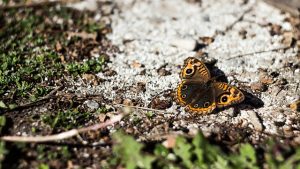
Fully grown, adult butterflies are very nomadic, and will search far and wide for nectar to feed on, and for good sites to lay eggs.
Wildflower meadows were always a favourite spot to see butterflies, but as more and more of these meadows are disappearing in the UK, this is no longer an option for most people.
Butterflies like chalky grassland like the Cotswolds, so those areas are always a good bet if you want to go take some photos, and you will sometimes see these creatures sheltering in cracks and crevices in walls and brickwork to protect them from the cold.
Butterfly diet – What do they eat?
When in their caterpillar stage, these insects eat plants and as we talked about above, each species of butterfly will lay their eggs on different plants, and so those caterpillars tend to live off those same plants.
After metamorphosis, adult butterflies live off nectar, which they drink from the flowers of various plants. Butterflies do not have mouths or teeth like some other insects, and instead use a proboscis, which is like a long tongue or tube, to suck up the nectar.
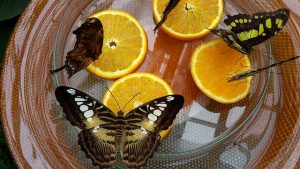
However, there are some butterflies that don’t need flowers to feed, and instead they survive by eating rotting fruit, animal excrement, and tree sap.
Butterfly hibernation and migration
It is not common for butterfly species native to the UK to hibernate. In fact, only five of the fifty-nine types of butterfly are known to do so, and even then there isn’t a huge amount of information out there about how, when, and where, some of them actually hibernate.
What we do know is that these hibernating species of butterfly do so alone, before awakening in Spring time and then going in search of a mate.
The five hibernating species found in the UK are peacocks, Comma, brimstone, Red Admirals, and small Tortoiseshells.
Some kinds of butterflies, like Monarchs and the Painted Lady will migrate for warmer temperatures when winter rolls around here, however there is a difference between how the two do so.
While Monarchs will find a nice war, spot and settle there, Painted ladies will stop in multiple places along the way back to their native Africa, breeding as they go, so the butterflies that come back are actually the offspring, several generations passed, of the ones that left the UK. Quite amazing really.
What eats butterflies in the UK?
When it comes to predators, butterflies have quite the rough ride, with multiple animals and insects using them as a food source, all through their life cycle. As caterpillars they are at the mercy of birds, ladybirds, and other predators. As adult butterflies they can fall prey to spiders, frogs, cats, dogs, and hedgehogs to name a few.
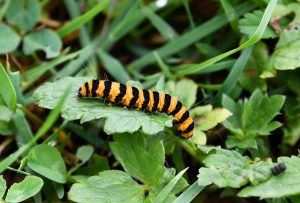
To protect themselves, both as caterpillars and adults, butterflies have developed ways to warn off predators such as laying their eggs on certain plants that are then eaten by the caterpillars. This specific diet makes the butterflies taste foul to birds. The monarch butterfly is a fine example of this, laying its eggs on milkweed.
Then of course, there are the patterns on the butterfly’s wings that can resemble large eyes, and the use of colours tell any hungry creatures that they shouldn’t be eating them.
One type of caterpillar, called the swallow tail, even has organs that it can push out that smell really terrible, and this can put off some predators.
How can we help protect butterflies?
There are a number of things we can do to help the UK’s butterfly population. For a start, stop using chemical pesticides to get rid of aphids. Instead, just use ordinary water with a little citrus added to it and spray the affected plants. It works wonders, and won’t kill butterflies.
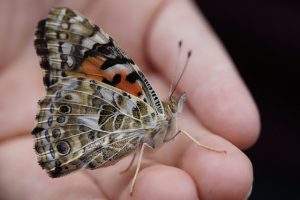
If you really want to help, you should do a little research into which species of butterfly are to host endangered, and then grow the plants that they like in your garden. Because of the fact that different species like different plants, trying to help all of them is just not possible in this way, so selecting the ones that are struggling the most seems like the best plan of action.
Most adult butterflies live off nectar, so having nectar rich plants and flowers in your garden is a sure way to help them out, but make sure these plants are native to the UK. Building a butterfly hotel is also a wonderful idea.
If you’re a butterfly collector, stop doing it. With modern technology, we all have excellent wildlife cameras at our fingertips, so you can capture these amazing creatures on photo, or in action on video. There’s really no need to capture and then kill them for the sake of your collection.
If you see a struggling butterfly in cold weather you can help save it by using the same method you would with bees. Gently, collect it and move it into a warmer drier spot, and then lay a teaspoon of water with some sugar dissolved in it in front of the butterfly and wait for it to drink it.
This solution should help the butterfly regain enough energy to get it’s wings moving again and then it can fly away before a predator gets a hold of it.
In conclusion
The combination of human expansion and development and climate change has had a huge effect on the butterfly population, and not in a positive way at all. We need to seriously address this, and bring it to the forefront of people’s attention, just like has been done with the demise of bees.
By educating people on the causes of butterfly numbers declining, we can surely get more people actively involved in helping to save these beautiful, enchanting, and very vital creatures. Failure to do so, would no doubt have disastrous effects on our ecosystem, and this could lead to all sorts of problems for all life on this planet, humans included.
So, let’s do our best to protect butterflies, their food sources, and their natural habitats, and hopefully it’s not too late to turn the corner and get their numbers going back in the right direction, promoting growth rather than decline, and preventing their possible extinction.
If we all do just a little to help, it’ll add up into something worthwhile, and wouldn’t we all like to live in a world where there are more butterflies? I certainly would.
